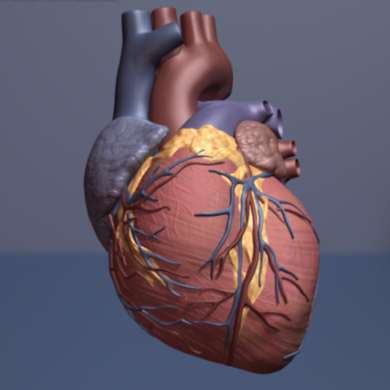Human heart. Credit: copyright American Heart Association
A research group from Shanghai and Moscow has developed a multi-scale model of coronary circulation, which nourishes the myocardium. The model is the first to account for key factors of the myocardial perfusion mechanism. The results of this study were presented in the International Journal for Numerical Methods in Biomedical Engineering.
Considering both hemodynamic parameters (e.g. vascular resistance and blood viscosity) and coronary flow autoregulation, this model allows scientists to study quantitative factors that affect transmural myocardial flow. "This model draws on the average population readings. That's why this study is fundamental. Practically speaking, we cannot adapt it to the heart of an individual patient, because it uses data that cannot be obtained in regular hospitals. However, the model explains some clinical observations about myocardial perfusion and gives us new knowledge about the influence of different pathophysiological factors on this process," says Yuri Vassilevski of Sechenov University, who is also associated with Moscow Institute of Physics and Technology and Marchuk Institute of Numerical Mathematics (RAS).
High vascular resistance and a dense capillary network are specific for cardiac vasculature, or coronary heart vessels, which provide the heart with oxygen and nutrients. Heart cells consume about 10 percent of all oxygen consumed. About a half of the entire heart capillary network is in a quiescent state, coming into play during high load. Coronary blood flow depends highly on the phase of the cardiac cycle. Due to all these factors, transmural myocardial flow is highly heterogeneous.
"In the first place, it is influenced by intramyocardial pressure, which is affected by myocardial contraction," says Fuyou Liang, the lead investigator of the study, affiliated with Sechenov University and Shanghai Jiao Tong University. As the subendocardial layer, the inner layer between the endocardium and epicardium, is more vulnerable to ischemia, this study is also important for understanding heart injury due to perfusion disruption.
Some computational models of myocardial perfusion were previously created to understand coronary hemodynamics. However, myocardial blood flow rate measurements were insufficient to deepen the understanding of these mechanisms. Without taking into account the vascular state and mechanical stress in the myocardium, the model will provide false predictions. Though the new model is not the first, it provides a more detailed description of the distribution of intramyocardial vessels, which brings the results to the next level. Additionally, the model improves the understanding of coronary circulation autoregulation mechanisms.
"Firstly, our numerical model demonstrated that heart rate, myocardial pressure and coronary perfusion pressure are the key factors influencing transmural myocardial flow; secondly, we show that endocardial flow to epicardial flow ratio grows along with heart rate reduction lead to both relative diastole prolongation and intramyocardial pressure reduction; thirdly, the study demonstrates mutual influence of intramyocardial and perfusion pressure on transmural myocardial flow," says Fuyou Liang in conclusion.
More information: Xinyang Ge et al. A multi-scale model of the coronary circulation applied to investigate transmural myocardial flow, International Journal for Numerical Methods in Biomedical Engineering (2018). DOI: 10.1002/cnm.3123
Provided by Sechenov University






















